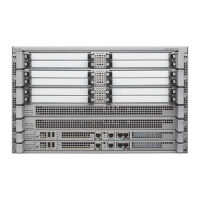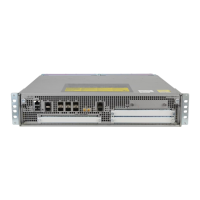PurposeCommand or Action
Configures a new ATM PVC by assigning its VPI/VCI numbers and enters ATM VC
configuration mode. The valid values for vpi /vci are:
Router(config-subif)# pvc
[name ] vpi /vci
Step 3
• name —(Optional) An arbitrary string that identifies this PVC.
• vpi —Specifies the VPI ID. The valid range is 0 to 255.
• vci —Specifies the VCI ID. The valid range is 32 to 65535. Values 1 to 31 are
reserved and should not be used, except for 5 for the QSAAL PVC and 16 for the
ILMI PVC. ILMI is unsupported on the Cisco ASR 1000 Series Aggregation Services
Routers.
When using the pvc command, remember that the vpi /vci combination forms a
unique identifier for the interface and all of its subinterfaces. If you specify a vpi
/vci combination that has been used on another subinterface, the Cisco IOS XE
software assumes that you want to modify that PVC’s configuration and
automatically switches to its parent subinterface.
Note
Configures the PVC for a particular protocol and maps it to a specific protocol-address .
Router(config-if-atm-vc)#
protocol protocol
Step 4
• protocol —Typically set to ip or pppoe for point-to-point subinterfaces, but other
values are possible.
protocol-address [[no]
broadcast]
PPP is not supported on the Cisco ASR 1000 Series Aggregation Services Routers,
and PPPoE is supported beginning in Cisco IOS XE Release 2.5.
Note
• protocol-address —Destination address or virtual template interface for this PVC
(as appropriate pertaining to the specified protocol ).
• [no] broadcast—(Optional) Specifies that this mapping should (or should not) be
used for broadcast packets.
The protocol command also has an inarp option, but this option is not meaningful on
point-to-point PVCs that use a manually configured address.
(Optional) Configures the ATM adaptation layer (AAL) and encapsulation type, where:Router(config-if-atm-vc)#
encapsulation {aal5mux
protocol | aal5nlpid| aal5snap}
Step 5
• aal5mux protocol —AAL and encapsulation type for multiplex (MUX)-type VCs.
A protocol must be specified when you use this encapsulation type.
• aal5nlpid—(IP only) AAL and encapsulation type that allows ATM interfaces to
interoperate with High-Speed Serial Interfaces (HSSIs) that are using an ATM data
service unit (ADSU) and running ATM-Data Exchange Interface (DXI). Supported
on ATM PVCs only.
• aal5snap—AAL and encapsulation type that supports Inverse Address Resolution
Protocol (ARP). Logical link control/Subnetwork Access Protocol (LLC/SNAP)
precedes the protocol datagram. This is the default.
Exits interface configuration mode and returns to privileged EXEC mode.Router(config-if)# end
Step 6
Cisco ASR 1000 Series Aggregation Services Routers SIP and SPA Software Configuration Guide, Cisco IOS
XE Everest 16.5
70 OL-14127-17
Configuring the ATM SPAs
Creating a PVC on a Point-to-Point Subinterface

